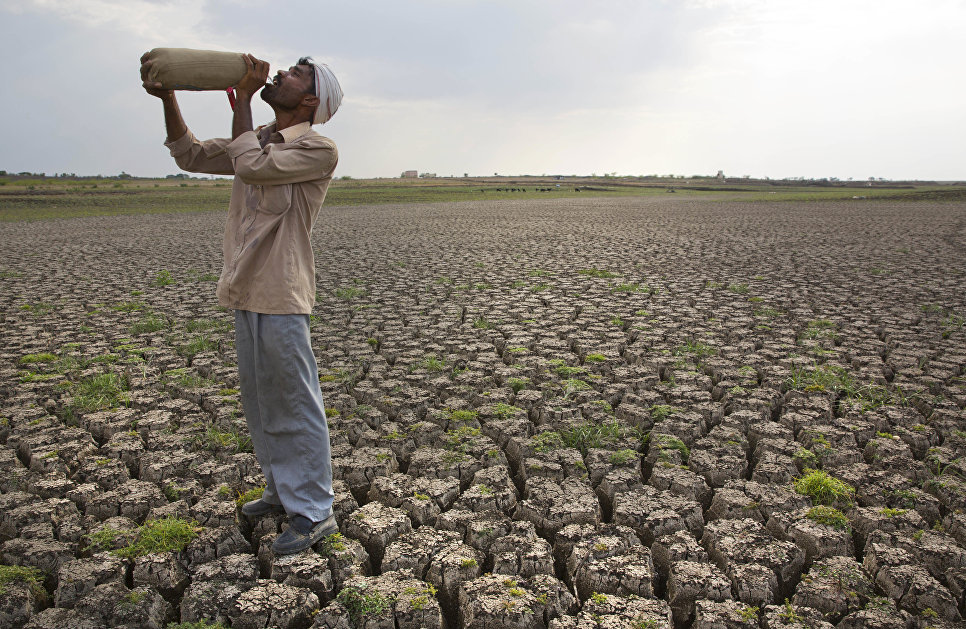 Source: AP Photo / Manish Swarup
Source: AP Photo / Manish SwarupSome regions of India, Pakistan, Bangladesh may become practically unsuitable for the life of people by the end of the century. This
gloomy forecast of climatologists will come true if the current dynamics of the increase in average annual temperature continues. Humidity and temperature in these regions should soon reach new, record highs,
according to the authors of the new climate model of South Asia. If global warming occurs, about a third of the population of the Indo-Gangetic plain will either have to leave their homes or stay and somehow adapt to the new conditions.
And to adapt is not so easy, if at all possible. “The most intense increase in temperature in the future will occur in the densely populated agricultural regions of Ganga and Indus,”
says a study conducted by a group of scientists from the Hong Kong University of Science and Technology. The work of scientists headed by Yon-Sun Imom differs from similar climatological studies in that it takes into account not only the temperature rise, but also the change in the humidity level. But this is also one of the key factors affecting the quality and standard of living of people.
Actually, not only the quality and standard of living, but also the life and health of a person depends on humidity and temperature. The fact is that in regions where it is humid and hot, it is very difficult for the body to adapt - our entire temperature exchange system is designed for the possibility of evaporation of fluid from the surface of the body. And if the humidity is under 100%, then there will be no evaporation, and the body overheats. If we are talking about a couple of hours, there may be no problems. But if the mode “for wear” works constantly, it will be reflected in health in the most negative way. Of course, the locals have developed certain adaptation mechanisms for many hundreds of years of a hot and humid climate, but everything has a limit, the resources of the organism are not inexhaustible.
In some regions of the Earth, where the temperature is very high,
it is still possible to
live due to the dryness of the climate. But in regions where it is both hot and very humid at the same time, it may soon become impossible to live. Thermal shock in such conditions may be followed for several hours already being outdoors.
“Now it’s hard for us to imagine that somewhere on Earth there may be conditions in which a person cannot stay even for a few minutes, but this problem is discussed in our article,” says Chris Field, a Stanford scientist who took part in the study. "And of course, the danger of harm to health in a hot, humid climate is most relevant for those who are sick or whose body is weakened - for example, for the elderly."
 Source: AP Photo
Source: AP PhotoThe most vulnerable people in India, Pakistan and Bangladesh are poor farmers and workers. It is they who are constantly outdoors (and in their homes the temperature and humidity are about the same as in the open), so in South Asia this category of people is in the “climate risk” group.
In order to test their point of view, scientists have processed statistical data on a powerful computer system, subsequently building a digital model of climate change in South Asia. In this model, the scenario was used, according to which the average annual temperature on Earth will rise by 2-3 degrees over the next few decades compared to the pre-industrial level while maintaining the level of greenhouse gas emissions. The situation will be very difficult even if people can achieve some reduction in emissions. In both the first and second scenarios, the temperature rise will affect about a third of the population of the above regions. The average annual temperature in this case will be about 31 degrees Celsius.
By the end of this century, the temperature will reach 35 degrees Celsius with a high level of humidity. In this case, about 60 million people will not be able to live in their native places, they will have to move.
The main problem for the region of the Ganges and the Indus is lowland, high precipitation in summer and, accordingly, high humidity. There are also many rivers and many irrigation systems created by man for many years. High temperature + evaporation = high humidity.
In the event that humanity can curb warming, the risks are reduced and very significantly. According to the authors of the study, the problem that they showed in their work can be solved. The main thing is to comply with paragraphs of the Paris Agreement (from which, by the way, the United States recently left). True, even if the warming process is delayed, the inhabitants of South Asia will still have problems. But in the latter case, far fewer people will suffer than the development of the scenarios described above.